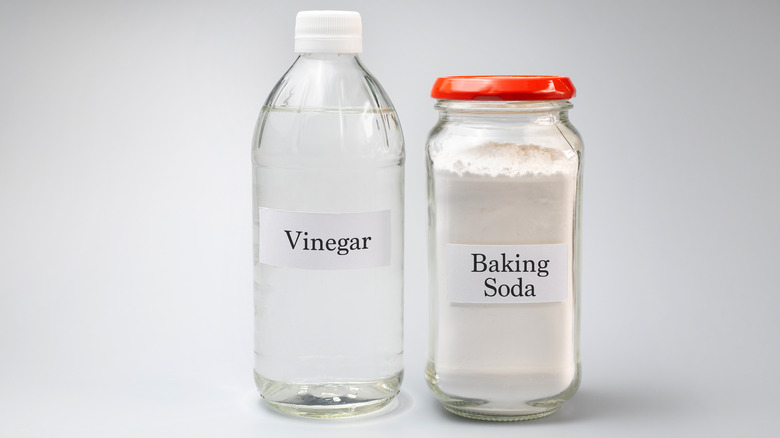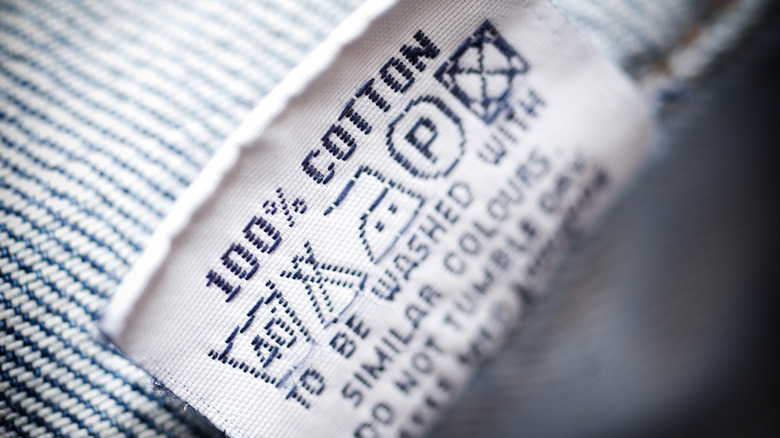This Laundry Ingredient To Brighten Whites Could Make Your Clothes Uncomfortable
It's no secret — bright, white clothes can fade over time. Excessive sun exposure and bleed over from other laundry that was washed in a machine can cause whites to turn yellow and gray. You may have noticed that some laundry detergents contain optical brightening agents (OBAs) and been tempted to try them out, but is it worth it? Unfortunately, optical brighteners are best avoided, and they can cause more harm than good. While it's true that OBAs will help your clothes look brighter and cleaner, there are some significant downsides to using them.
For one, optical brighteners can make fabric very stiff and uncomfortable. They can also irritate the skin and cause allergic reactions. This is because residue from these chemicals will stay on your clothes long after you've washed them. On top of this, optical brighteners aren't eco-friendly and can cause a lot of harm to the environment. Since they biodegrade very slowly, they'll build up in local bodies of water and can risk aquatic life in the area. Fortunately, there are a lot of other great ways to keep your clothes white and bright, so consider using them instead of optical brightening agents.
What you should use to brighten your clothes instead
Instead of using optical whiteners to brighten your clothes, opt for laundry detergents and products that are eco-friendly, have a "Safer Choice" seal, and don't contain optical brighteners. These store bought products won't cause harm the way products with optical brighteners will. Even better, you may want to consider using simple pantry staples that will keep your clothes bright such as white vinegar and baking soda.
To brighten your clothes with white vinegar, you'll simply need to soak your clothes in a mixture of hot water and vinegar for at least one hour, or overnight. Use one gallon of water to one cup of distilled white vinegar. Another option is to add between half to one cup of white vinegar to the wash. Alternatively, you can add half a cup of baking soda to your washing machine during a wash cycle and then add half a cup again for the rinse cycle. Both ingredients do a very good job of brightening and cleaning your clothes. They can be well worth using if you want to be more eco-friendly and avoid the problems that come with using optical whiteners.
Other ways to reduce skin irritation
If you've been experiencing skin irritation due to your clothing, part of the reason could be that you're using optical brighteners. However, there are other reasons why skin irritation may occur as well. It's possible that you have textile dermatitis and are allergic to a particular garment or fabric. If so, you'll want to consider retiring that item from your wardrobe and no longer wearing it.
Remember that you should opt for soft, natural fibers such as cotton, silk, and cashmere whenever possible. Synthetic fabrics are more likely to cause skin irritation and contact dermatitis due to a lack of breathability and the presence of chemicals and dyes. Similarly, clothing with lighter colors usually contain less dye and will be easier on the skin as well. You should also avoid clothes that have labels such as "wash separately" on them because these may leak dyes and cause skin irritation. Also avoid clothing with "non-iron" and "dirt-repellent" labels since these are likely to have been treated with chemicals.
Finally, be sure you're using gentle detergents that are meant for sensitive skin whenever possible. You might also want decide on something to substitute for laundry detergent such as baking soda or vinegar. You should also avoid fabric softeners since these are a common cause of irritation to the skin. You may want to DIY your own fabric softener with common cleaning ingredients you already have to reduce skin irritation.


